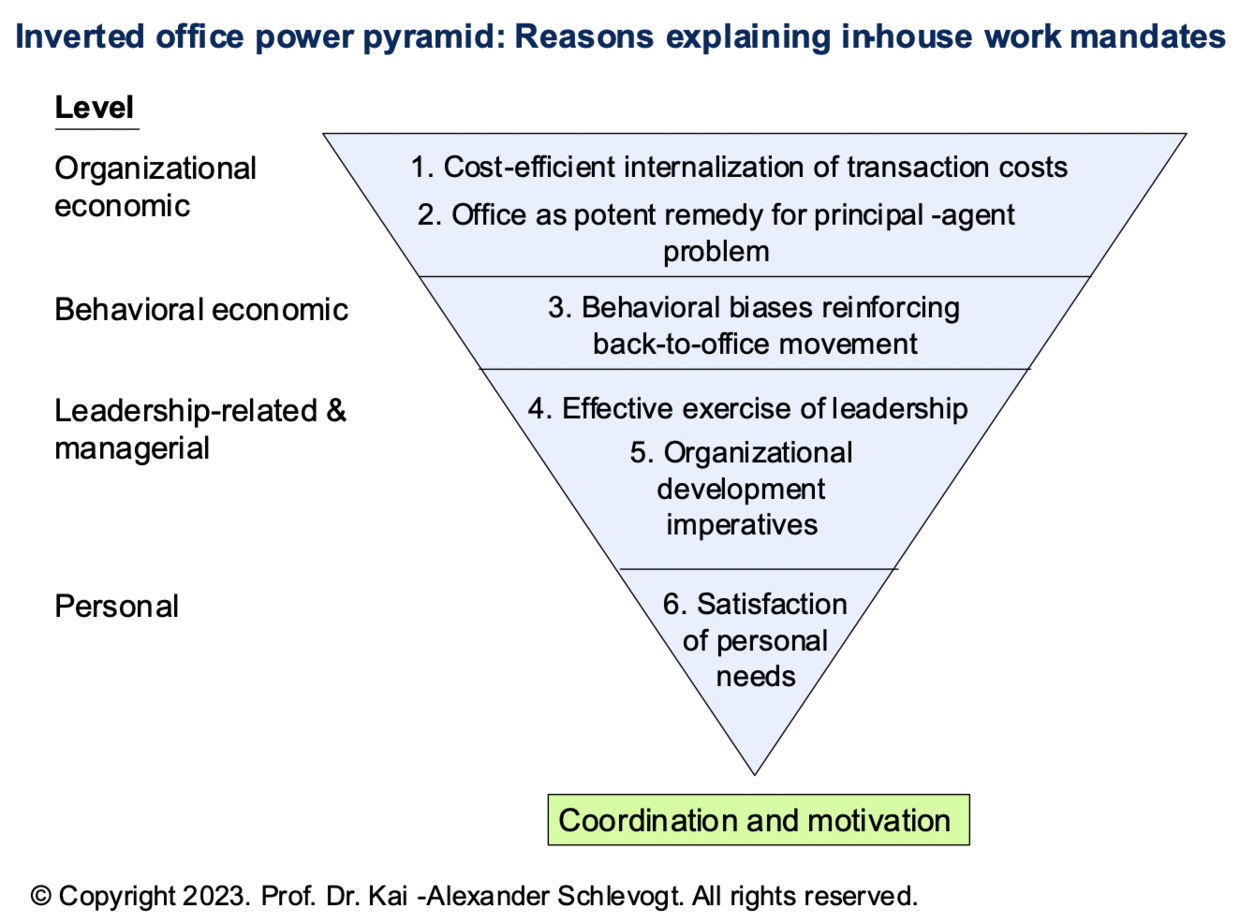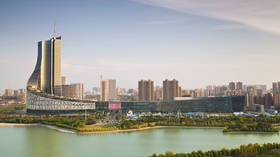
What are the reasons for leaders decommissioning virtual water coolers?

By Prof. Dr. Kai-Alexander Schlevogt, a globally recognized expert in strategic leadership and economic policy, who has served as Full University Professor at the Graduate School of Management (GSOM), St. Petersburg State University (Russia), where he held the University-Endowed Chair in Strategic Leadership. He also held professorships at the National University of Singapore (NUS) and Peking University.
By Prof. Dr. Kai-Alexander Schlevogt, a globally recognized expert in strategic leadership and economic policy, who has served as Full University Professor at the Graduate School of Management (GSOM), St. Petersburg State University (Russia), where he held the University-Endowed Chair in Strategic Leadership. He also held professorships at the National University of Singapore (NUS) and Peking University.
kai-alexander.schlevogtschlevogtwww.schlevogt.com

© VioletaStoimenova / Getty Images
Somewhere in a remote Russian village, there was a frog sitting in a rut. His amphibian fellows beseeched him to leave the prison-like furrow to live a better life in freedom. Yet the batrachian stubbornly refused to do so, since he wanted to avoid the effort, albeit small, of jumping out of the rut. One day, a horse-drawn carriage approached. When it was very close, the frog immediately jumped out of the track to prevent being crushed.
This is where the frog story usually ends. It illustrates how a sense of urgency (to use change management jargon) sometimes can act as a powerful push to alter one’s habits without further ado, even if those are deeply engrained. The sudden switch to work from home (WFH) during the COVID-19 pandemic is an example of such a sudden, dramatic behavioral shift due to an external shock.
In the WFH case, the only – and fundamental – difference to the story line is this: After the pandemic, the frog jumped back into the rut! Translated to the world of work, the following trend emerged: leaders and their employees around the globe (i.e., the frogs), already accustomed to the freedom of operating virtually, returned to physical offices (i.e. the rut) due to new, stringent in-house work requirements (see Prof. Schlevogt’s Compass №3).
My “Inverted office power pyramid” model (see Figure 1) explains the seemingly unstoppable trend of bosses calling their employees back to the office after a prolonged period of WFH. It covers the following levels: (1) Organizational economic, (2) behavioral economic, (3) leadership and managerial, and (4) personal.
Figure 1

© Prof. Dr. Kai-Alexander Schlevogt. All rights reserved.
In my previous column (see Prof. Schlevogt’s Compass № 4), I analyzed the first two levels, discussing the following reasons for office mandates: (1) The office facilitates the cost-efficient internalization of transaction costs, (2) the office can act as a potent remedy for the principal-agent problem, and (3) behavioral biases are reinforcing the back-to-office movement. Apart from these reasons, there are the following additional factors, which explain office mandates at the leadership-related and managerial level.
4. Effective exercise of leadership
For a long time, modern management experts believed that to succeed, an executive needs to sit at his desk and fulfill the classic functions proposed by Henri Fayol, a French thinker on business administration. Those included developing (usually grand) plans, organizing, commanding, coordinating, and controlling. In stark contrast, through extensive field research, Harvard Business School Professor John Kotter unearthed a completely different answer to his question of what effective general managers really do. In particular, he discovered that those individuals act in a significantly less systematic, proactive, deliberate, reflective, formal, organized and disciplined way than previously expected. Kotter’s research on how managers in actuality are spending their time revealed a fragmented pattern, with executives engaging in many informal meetings, which helped them to develop agendas and networks. The findings apply to leaders, too.

Read more
Similarly, according to the concept of ‘Managing by walking around’ (MBWA), it makes great sense for executives to simply wander through the office in a planless and random fashion to get a sense of the state of work, discover problems, and boost morale. This technique, which is comparable to the Japanese ‘Gemba walk,’ contrasts with the previous traditional prescription for managers to sit in their office and simply wait for formal and scheduled status reports from their subordinates. Due to well-known recurring processes, in the classic model, these employees usually have sufficient time and leeway to build Potemkin villages (facades without substance) designed to fool the corporate czar.
Given the great benefits of the overarching and integrative concept of what I call “leadership in the hallway”, bosses – in an oxymoronic, quixotic, and pitiable attempt to structure spontaneity – tried to put in place interactive substitutes for remote workers during the COVID-19 pandemic. Perhaps the epitome of attempts made at imitating the office, to make up for the deficiencies of remote work, is the ‘virtual water cooler.’ In essence, this was a digital meeting place where teleworkers were welcomed (and, frankly, supposed) to gather whenever they had time. Such virtual replacements for non-scheduled and informal personal interaction between leaders and their followers and among followers did not produce satisfying results, though.
For example, as a rule, comparatively few teleworkers showed up at the virtual water cooler during their free time between a series of demanding and exhausting video conferences. Among other things, a visit to the waterless fountain for them would have signified yet more time to be spent in front of their loathed computer screens, possibly while their young children were crying somewhere in the background. This scenario contrasted sharply with the previous relaxing break in the office, which afforded an opportunity to quench one’s thirst not just for water, but also for spontaneous, non-supervised socializing, including much-desired chatting.
Due to the comparative ineffectiveness of the virtual surrogate, managers are now increasingly decommissioning virtual water coolers and instead are calling their staff back to the office, where everyone again can engage in spontaneous, “miraculous” hallway conversations at liberty and ad libitum.
In general, the effective exercise of personal leadership – especially the charismatic variant, conceptualized by the German sociologist Max Weber (1864 -1920) – hinges on personal contact, be it in the hallway or office rooms. In propaganda classes during the time of the Soviet Union, students used to learn that indoctrination is most effective if the respective messages are delivered face-to-face and that it is very important to engage people in personal discussions to convince them. In contrast, reliance on virtual leadership or artificial intelligence makes it very difficult to role-model desirable behavior, inspire others and to transform them. Virtual ‘leadership’ is particularly problematic given the modern tendency of organizations to be over-administered, but underled (cf. Bennis, Warren G., & Nanus, Burt. (1985). Leaders: The strategies for taking charge. New York: Harper & Row.). The leadership gap has widened in recent times, during which compliance with political correctness mandates and complex regulations seems to be more important than creativity and innovation.
It might be argued that strategic leadership (the leadership of entire organizations as opposed to personal leadership) in an organization of considerable scale is different, because a leader of a large entity may never meet all subordinates in-the-flesh; therefore, some may argue, leadership could as well be exercised virtually. For example, the ancient Greek historian Xenophon in his book Cyropaedia praised king Cyrus the Great for exercising effective leadership over subjects in widely dispersed territories, who had never seen him, but still followed him. However, this argument in favor of virtual leadership only allows us to shift the fundamental problem to a lower level. This is because great strategic leaders build a strong bench of subordinate leaders at various levels in the hierarchy who will need to exercise leadership face-to-face.

Read more
Finally, a ‘cascading effect’ will most likely boost office attendance. If leaders show up in the office five days a week, employees probably will feel morally obliged to follow suit; if not, leaders will use their power to ensure compliance.
5. Organizational development imperatives
Developing an organization requires intensive office work and cannot be done exclusively remotely. This is one of the key points mentioned in a series of internal missives that top leaders at renowned companies such as Amazon, BlackRock, JPMorgan and News Corp. issued to their employees, to explain them why they called them back to the office. An in-depth look at some of the pivotal processes of an organization is helpful to understand this issue.
Collaborating and competing
Let us start with an insight from economics. Many types of modern collective work processes can be theoretically understood using the concept of ‘team production,’ which is characterized by a ‘joint production function’ (cf. Milgrom, Paul, & Roberts, John. (1992). Economics, organization, and management.) This means that the output of a group is created jointly by its members, is interwoven, and cannot be divided into discreet parts. This makes it impossible to identify and measure individual contributions. An example is the outcome of an informal brainstorming session.
In the case of team production, tasks cannot be parceled out and assigned to remote employees working in isolation. In addition, intensive collaboration, which is a necessary condition for the success of team production, is partially inhibited by the artificial constraints inherent in virtual communication. Such exchanges are reductionist in nature, contrasting with the richness of in-the-flesh communication. An example of this phenomenon is a pale and boring video conference via Zoom, in which – so far at least – participants can only speak sequentially. Even if they were to speak all at the same time, the resulting mishmash would be more difficult to disentangle virtually than in the office. Moreover, it is extremely difficult to integrate several dispersed teleworking teams.
These theoretical points are supported by practitioners’ testimonies. For example, John Stankey, the CEO of the telecommunication company AT&T, insisted in a conversation with the news agency Bloomberg that some things need to “be done sitting side by side”. In an internal missive cited by Bloomberg, the CEO of the media conglomerate News Corp., Robert Thomson, stressed that “attendance is an absolute imperative as collaboration and cooperation are priorities for each of our business.”
Besides, non-verbal communication, which is a key component of human interaction, is more difficult to observe virtually than during in-person meetings in the office. In the above mentioned memo, the CEO of News Corp., Robert Thomson, stated eloquently that WFH provides no space for the “subtleties of body language and the nuances of knowing glances.” The CEO of the asset-management firm BlackRock, Rob Goldstein, made the following statement in an internal missive: “We have felt the energy generated by being together, in our larger offices, our newer spaces… this energy, and the horizontal collaboration it powers, are what make BlackRock so special.” In addition, if – to use a modified version of an aphorism of the French writer Antoine de Saint-Exupéry (1900-1944) – harmony in teamwork consists not only of gazing at each other, but also of looking in the same direction, such harmony at present cannot be achieved virtually.
Finally, in the case of team production, there is a strong incentive for participants to shirk, since individual output cannot be observed. This is known as the ‘free rider problem,’ which occurs in some rowing teams, for instance. In such cases, individual behavior (in particular individual efforts) needs to be monitored instead of futile attempts to discern individual output. Again, such monitoring is easier done in the office than remotely.

Read more
The antidote to collaboration is competition, which – in healthy doses – is also crucial for an organization. Internal rivalry works better in an office, where you can literally feel and suck in the breath of your situational opponent, than remotely. To understand this point, just contrast the reality of an exciting F1 race, which engages all human senses, with a comparatively pale racing game on the computer screen.
Promoting learning
The success of an organization critically depends on its ability to enable its members to learn continuously and to store the results of such learning in its institutional memory. Yet again, work from home impedes the acquisition of competencies and knowledge in certain cases. For example, the magazine “The Economist” reported that workers in offices were found to gain new skills, an important constituent of human capital, more quickly than remote workers.
In particular, ‘learning through osmosis’ – at least with respect to the entirety of its dimensions – seems to be impossible virtually. Applying the concept of osmosis, which in biology is the movement of liquid through an organism’s membranes (cell coverings), to an organization, we can conclude the following: The process of incidentally and passively absorbing skills and knowledge, for instance, through automatic imitation of a role model, depends on personal contact through permeable ‘analog’ membranes. An example of such spontaneous learning would be to look a more experienced colleague over the shoulder and instinctively copy what he or she is doing. In contrast, such osmosis in its full richness cannot happen if there are rigid electronic walls between the transmitter (a superior or some other person) and the potential recipient. The above comments also apply to more formalized learning. Just compare an apprentice who is learning from a master, who guides his hands, to one who must learn a craft from home, possibly through recorded teaching sessions only.
Furthermore, it is more difficult to leverage spontaneous teaching and mentoring opportunities remotely than in-house. This point is supported by the following remark that the above-mentioned CEO of BlackRock made to justify office mandates: “Career development happens in teaching moments between team members, and it is accelerated during market-moving moments… All of this requires us to be together in the office.” Naturally, it is also more challenging to ask for assistance in a highly structured virtual environment than in an organic office setting. The operating committee of JPMorgan stated in an internal missive, which was leaked to the Financial Times, that its leaders “have to be visible on the floor, they must meet with clients, they need to teach and advise, and they should always be accessible for immediate feedback and impromptu meetings,” stressing that such presence accelerates learning, among other things.
Worse, apart from just slowing down or preventing learning (that is, a problem of underdevelopment), telework can lead to a degrading of skills. This is partially due to a reduction in feedback when work is shifted to the home.
Moreover, PwC and Deloitte found that graduates, whose studies had been interrupted by a period of remote work during the COVID-19 pandemic, performed worse on crucial performance parameters such as teamwork, communication skills, confidence, networking, adaptability, and resilience than previous intakes who had studied only in presence. As a consequence, these professional-services firms decided to offer special make-up courses and coaching for the deficient target segment.
Fostering creativity and innovation
Work from home also exerts a negative influence on creativity and innovation, which is closely connected to moving up the learning curve and thus is impacted in similar ways. Rob Goldstein, the CEO of BlackRock, made the following remark in the internal missive cited above: “When fast-moving, high-client-interest events are happening, having our teams physically together to find solutions, seize opportunities and learn from each other makes a difference.”
Furthermore, a Stanford economics professor, Nicholas Bloom, found that it is more difficult to challenge superiors virtually than in the office. One reason might be the fear of subordinates that all of their remarks are recorded and could be used against them in the future. However, critical and candid feedback is important for pinpointing problems and finding new solutions.

Read more
Moreover, the lack of spontaneous encounters, such as unscheduled hallway conversations, impedes out-of-the box thinking and innovation. For example, blinded by success, the management of Silicon Valley Bank (SVB), the collapsed US bank focusing on financing high-tech startups, failed to envision the negative outcome of a highly risky securities bet and to hedge against it. One reason for this lack of alternative views might have been the fact that the bank relied almost entirely on remote work and lacked effective face-to-face channels to discuss this business decision, formally and informally.
In addition, many people regard video calls as a veritable killer of creative thinking. Rather ironically, new technological solutions are being created to compensate for the problems that technology created in the first place – a movement that at times goes full circle. For example, Microsoft introduced a feature that makes it possible to use an animated 3D avatar (an image that represents a user) to disguise one’s face in a ‘Team meetings’ video call. In essence, it thus enabled users to convert a video call back into a traditional phone call, which, however, is laden with new problems. For example, giving feedback and looking for innovative solutions might be particularly uncomfortable when you need to deal with masks.
In addition, especially new employees often see many opportunities for improvement during what I call an ‘innovation honeymoon’. If they are getting on board remotely only, the possibility of discovering improvement potential in hidden corners diminishes dramatically.
Developing the organizational culture, trust and networks
To make a judgment about the future of the office, many people are just inquiring whether a given activity could be performed from home, too. According to this logic, an organization would not be needed at all if all tasks could be completed remotely. But this type of reasoning misses the following crucial point: An organization is more than just the sum of its parts or a bundle of activities. Instead, it often is comprised of valuable intangible assets, including organizational culture and esprit de corps. Constituting the set of values of an entity, culture is the glue that holds an entity together. It fills the holes in contracts, which cannot be perfect in an uncertain and complex world. It thus prevents to some degree undesirable postcontractual opportunism. Esprit de corps is morale, enabling an organization to face adversity.
The development of a strong culture and morale hinges on organizational members interacting personally in the office on a regular basis. Occasional offsite events cannot effectively substitute for such constant culture building. In the above-mentioned corporate memo, the operating committee of the investment bank JPMorgan justified office mandates for its managing directors by stressing the following point: “Our leaders play a critical role in reinforcing our culture.” Amazon’s CEO, Andy Jassy, nostalgically justified his call for office attendance in an internal blog as follows: “There is something about being face-to-face with somebody, looking them in the eye and seeing they’re fully immersed in whatever you’re discussing that bonds people together”.
In the final analysis, a strong culture and esprit de corps can only be perpetuated if new hires are inculcated with their organization’s values. Office time matters particularly for this group, because it makes it possible for its members to absorb organizational values hands-on from personal role models, especially organizational leaders, both in structured and unstructured formats. As a rule, during the COVID-19 lockdowns, universities around the world found it impossible to enculturate new students, whose study experience consisted only in a permanent stream of video conferences. This resulted in pervasive desperation and lack of orientation among this group of students. Furthermore, it is particularly challenging to develop a culture of empathy in a remote-only setting where it is more difficult to gauge a person’s feelings than in an office, where you can intensively observe your colleagues at will.

Read more
Moreover, SVB, the above-mentioned financial institution, encountered great difficulties in socializing a large number of new staff hired both as replacements for numerous resignations and to accommodate its rapid growth, since it relied almost entirely on remote work. By the same token, after the Great Resignation in the aftermath of the COVID-19 pandemic and frequent switches of workers to new employers, the office will grow in importance, because it is a better place for enculturating newcomers than a workplace at home, where a job consists only of a permanent video conference.
In addition, the development of trust hinges on frequent face-to-face interaction with people and knowing them well. One reason for this tendency is that due to proximity bias, humans are prone to place more trust in those who are nearby rather than far away. Undoubtedly, a great amount of trust has been lost during the WFH spree. Now the office will be a crucial place to rebuild this type of invaluable intangible capital.
Finally, building social capital (the value embedded in relationships) also critically depends on personal encounters in a physical office. In contrast, according to The Economist, the barriers created by the radical switch to remote-only engagements led to more static and encapsulated networks. It is important to consider interdependencies, too. Without stable networks, it is very difficult to store knowledge internally.
As shown in my ‘Inverted office power pyramid’, a final layer of factors explaining the recent push for office attendance can be found at the personal level and concerns personal needs. [To be continued]
Prof. Schlevogt’s next column will unearth additional fundamental forces at work driving the seemingly unstoppable return-to-office megatrend at the personal level.
Note to readers: Please feel free to submit your questions related to a wide variety of political-economic issues in the comment section of this column. Prof. Schlevogt will subsequently endeavor to address these issues in his future columns.




